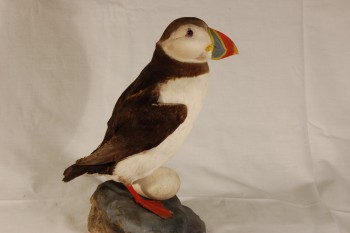Objects and specimens relating to Natural History make a major contribution to the museum’s overall collection.
The Orkney Natural History Society had already amassed several hundred mineral, fossil, zoological, seaweed and shell specimens by the time of the First Annual Report in 1839. Many of these early acquisitions were collected by members and office-bearers, such as the Society’s first president Rev. Dr. Charles Clouston, who was a keen collector and identifier of seaweed, and Robert Rendall, whose seashells form a key collection.

These collections have continued to be added to throughout the museum’s history, and specimens and exhibits now include many world class examples of geology, zoology, marine botany and malacology. In the first-floor galleries, you can see a large number of taxidermy specimens, including a Golden Eagle and a Puffin, and a mounted specimen of the iridescent Morpho butterfly, one of the largest butterflies in the world.
Other highlights include the Homostius milleri fossil, otherwise known as the Asterolepis of Stromness, whose 19th-century discovery by Hugh Miller inspired Charles Darwin, and the fossilised spine of a Plesiosaur, a marine reptile which lived in the Jurassic period, over 150million years ago!
Other Research Collections within Natural History are available to view by appointment only.




